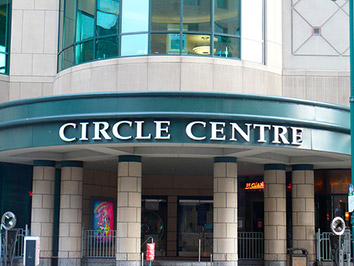Subscriber Benefit
As a subscriber you can listen to articles at work, in the car, or while you work out. Subscribe NowThe Indianapolis downtown TIF district is so flush with cash that the mayor can cover all its debt payments, fund two layers of reserves, and still have tens of millions to spend at his discretion.
Free cash in the downtown TIF could amount to $59.3 million by the end of 2018, according to the city controller’s projections.
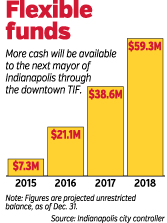 Like all tax-increment financing districts, the downtown TIF is essentially a reservoir for property-tax revenue that otherwise would flow to government units throughout the county. The way cash is piling up in the city’s largest TIF raises the question: Is it time to open the floodgates?
Like all tax-increment financing districts, the downtown TIF is essentially a reservoir for property-tax revenue that otherwise would flow to government units throughout the county. The way cash is piling up in the city’s largest TIF raises the question: Is it time to open the floodgates?
“It definitely allows an opportunity,” Controller Matthew Kimmick said.
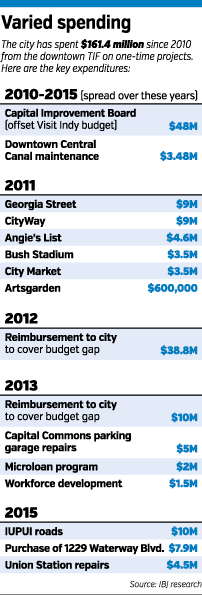 TIF districts capture incremental property-tax revenue to pay off debt issued for economic-development projects. The downtown TIF has helped fund a long list of developments—from Circle Centre mall to Flaherty & Collins’ luxury apartments on the former Market Square Arena site—since it was created in 1982 to kick-start the rebirth of downtown.
TIF districts capture incremental property-tax revenue to pay off debt issued for economic-development projects. The downtown TIF has helped fund a long list of developments—from Circle Centre mall to Flaherty & Collins’ luxury apartments on the former Market Square Arena site—since it was created in 1982 to kick-start the rebirth of downtown.
During Republican Mayor Greg Ballard’s first term, the downtown TIF began accumulating enough excess cash to also fund one-time projects, such as construction of the Georgia Street pedestrian plaza in 2011, and road improvements on the campus of IUPUI negotiated last year as part of an agreement to overhaul the natatorium.
“Now it’s just a slush fund,” said City-County Council Democrat Zach Adamson, a TIF critic.
Adamson said the fact the downtown TIF is helping fund things like luxury apartments and Indiana University-owned property shows it’s no longer serving an economically depressed area in need of transformation.
TIF critics like Adamson also are frustrated because cash-funded projects don’t need council approval. While Adamson voted against issuing bonds for Flaherty & Collins’ $121 million apartment tower, he had no say on whether to spend $10 million on roads at IUPUI. That decision rested with the Metropolitan Development Commission, a majority of which is mayoral appointees.
Ballard plans to spend $22 million on one-time projects this year and leave $7.3 million in the fund when he steps down Dec. 31 after two terms.
This year’s spending includes the IUPUI roads, repairs to Union Station and buying a Citizens Energy property on Waterway Boulevard to create a shovel-ready site for the 16 Tech business park.
There’s no shortage of demand for downtown improvements. In an interview with IBJ, Democratic mayoral hopeful Joe Hogsett said he’s hearing a drumbeat from downtown stakeholders for a makeover of Circle Centre. He also foresees the need to boost Monument Circle as a family attraction.
 Hogsett
HogsettHogsett declined to get into specifics about how he would finance economic development. He’s aware the downtown TIF could be perceived as benefiting real estate developers, but he’s not ruling out any tools at his disposal.
“I think it ought to be used very cautiously,” he said of the downtown TIF’s excess cash.
Chuck Brewer, the Marion County GOP’s endorsed candidate, declined to comment ahead of the May 5 primary, in which he faces two opponents, Jocelyn Tandy-Adande and Terry Michael.
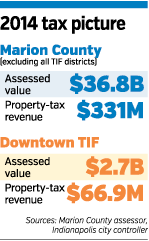 Reversal of fortune
Reversal of fortune
The downtown TIF struggled to meet its debt obligations under former Democratic Mayor Bart Peterson.
The shortfalls were driven by property-tax reassessment and successful appeals by major corporate taxpayers, said Bob Clifford, who was director of the Indianapolis Bond Bank and then controller under Peterson.
The city covered those shortfalls partly by expanding the TIF so that it captured personal property taxes on the equipment at Eli Lilly and Co., Clifford said. Lower interest rates, which allowed for bond refinancing, also helped. So did tax increases for Indianapolis Public Schools’ multi-stage capital improvement program, he said.
Part of the tax hike IPS levied is captured by the downtown TIF. “It was IPS’ capital plan that saved the TIF,” Clifford said.
The Ballard administration is free to share the largesse by releasing some of the downtown TIF’s $2.7 billion in assessed value to Marion County as a whole. It’s already doing so on a small scale, but doesn’t seem inclined to ramp that up.
 Hicks
HicksIPS is the single-largest entity that benefits from city decisions to release revenue from the downtown TIF, but it has no say in the process.
Ball State economist Michael Hicks said that’s the real problem with TIFs—no discussion takes place about the merits of economic-development projects versus the adequacy of basic services, such as public safety and schools.
“That’s the debate that has to happen, and TIF circumvents that debate.”
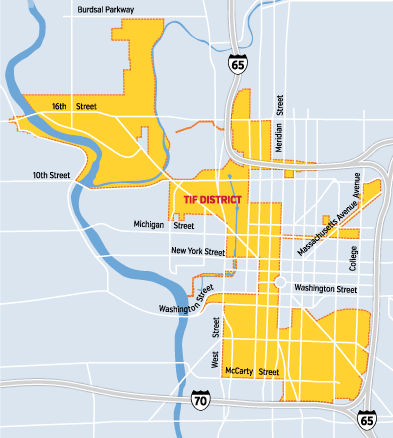 City has leeway
City has leeway
There’s no set policy on how much should remain in the downtown TIF, or any other TIF, said Kimmick, the city controller. The controller evaluates how much each district needs to cover obligations, reserves and special projects and tries to avoid huge fluctuations from year to year, he said.
For this year, Indianapolis released $185 million of the downtown TIF’s assessed value. That resulted in $5.3 million in revenue for other government entities, including city and county general funds and IPS.
The city could unlock even more of the downtown TIF’s value, but because of Indiana’s property-tax caps, it would lose some revenue in the process.
If the downtown TIF were dissolved tomorrow, the $74.5 million it’s projected to collect next year would be filtered through the tax caps—resulting in lower bills for some taxpayers—leaving $35.9 million for government coffers, according to a city analysis.
IPS interim financial manager Paul Carpenter-Wilson hopes the city will at least provide informal opportunities to weigh in on the downtown TIF in the future. The city controller, county officials and finance chiefs from governments across Marion County meet each quarter to discuss various issues, he said.
The fact that Indianapolis shares a slice of the downtown TIF money with the rest of the county has helped avert restrictive legislation in the General Assembly.
The Indianapolis downtown TIF was the only exception to a 2014 law that required all TIF districts created before 1995 to dissolve by 2025. Lawmakers cited the city’s past revenue-sharing practice as one reason for special treatment.
Former Ballard controller Jeff Spalding said TIFs are a useful tool—he engineered the use of $38 million in TIF funds to cover a budget shortfall—but that Indianapolis needs a set policy for using excess cash.
“What’s still missing is the plan,” he said.•
Please enable JavaScript to view this content.

